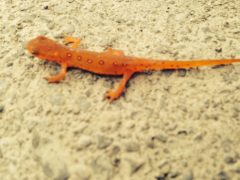I was walking on the weekend when I came across this little amphibian. Many of you will have recognized this as a red eft
the terrestrial stage of a salamander species common to this neck of the woods (or at least to ponds therein). A couple of things are worth noting. The picture was taken with my iphone and while there is no scale, the eft was about as long as my pinky finger (which incidentally is also the width of my iphone). This is the terrestrial stage of the eastern newt (Notophthalmus viridescens), which can live up to 15 years in the wild. As a parasitologist, I remember vividly a study by Gill and Mock in the mid 1980’s showing that individuals of this species can have very high parasitemias of a trypanoma species (similar to the protozoan that causes African sleeping sickness in humans). If my understanding of the life cycle of this amphibian is correct, the terrestrial phase is a juvenile phase that looks like a typical adult salamander and the adult aquatic phase looks more larval with vanes on the tail (correct me if I am wrong, Glen Kit ~ lab coordinator at Carleton). At any rate, the adults had very high parasite counts of this flagellated protozoan in their blood and the authors could not find obvious fitness costs to having these parasites. More recently, there has been a push toward trying to understand tolerance to parasites, which herein can be defined as the host’s ability to minimize virulence of a parasitic organism without minimizing the parasite’s numbers or density. A lot of sickness comes from the immune system attacking the parasite and cases of immunopathology are well known. Perhaps this little amphibian could have been a model lab animal on tolerance if we paid more attention to Gill and Mock’s results, back in the 80’s.
Reference
Gill De,Mock Ba. 1985. Ecological and evolutionary dynamics of parasites: the case of Trypanosoma diemyctyli in the red-spotted newt, Notophthalmus viridescens. In Ecology and Genetics of Host-Parasite Interactions. In D. Rollinson and R.M. Anderson, eds. Linn. Soc. Seminar Series 11: pp 157-183. Academic Press: London.